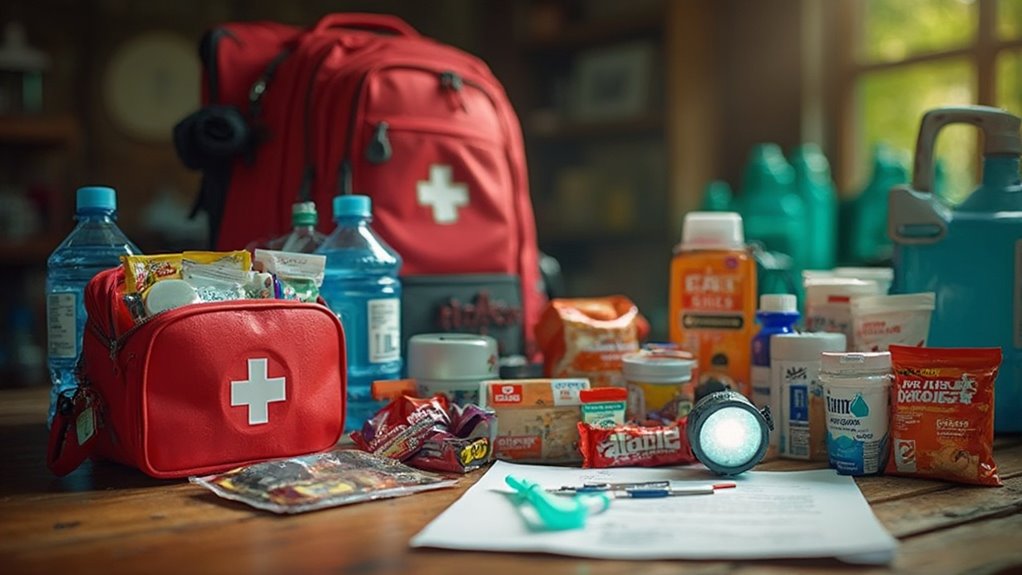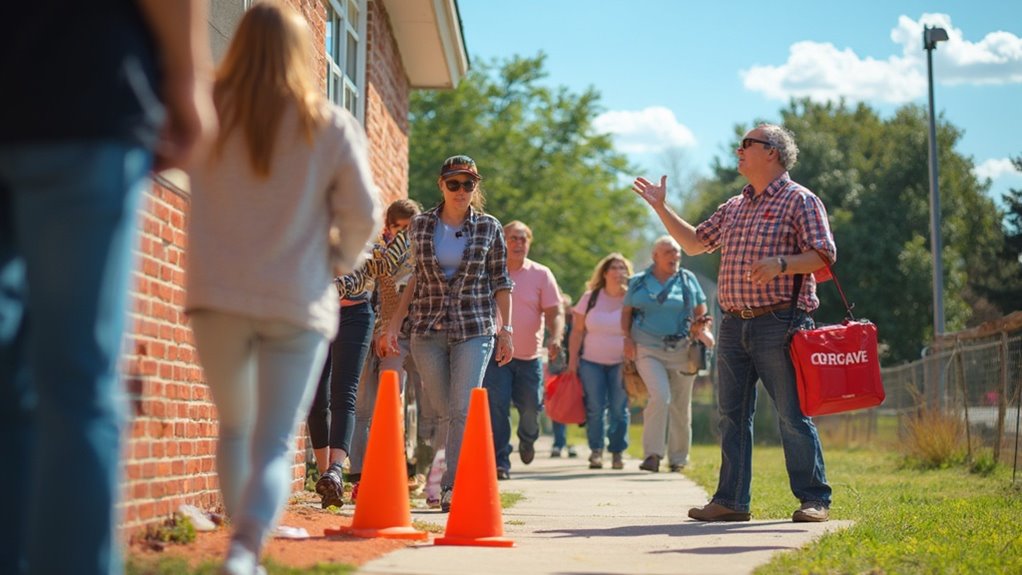Care Pro Restoration empowers you, the residents of Smyrna, to tackle emergencies effectively. By understanding local risks like floods and hurricanes, you can develop tailored emergency plans that include evacuation routes and vital supplies. They provide rapid response teams that arrive within 60 minutes to assist during crises, addressing immediate needs and ensuring safety. You'll benefit from their expertise in damage evaluation and insurance claims, streamlining your recovery process. Moreover, ongoing training and community awareness improve readiness. There's more to uncover about how to sharpen your preparedness strategies and safeguard your home against potential threats.
Key Takeaways
- Care Pro Restoration offers rapid response teams that arrive on-site within 60 minutes during emergencies, ensuring quick assistance for Smyrna residents.
- They provide thorough damage evaluations and documentation support, essential for insurance claims and recovery after disasters.
- The company collaborates with local emergency management and agencies like FEMA to facilitate comprehensive post-disaster assessments and recovery efforts.
- Care Pro Restoration emphasizes the importance of regular drills, helping the community stay prepared and informed on emergency procedures.
- Their services include mold remediation and hazardous debris removal, ensuring that affected areas are secured and safe for residents.
Understanding Local Risks

Understanding local risks is vital for effective emergency preparedness. In Smyrna, you face various natural disasters, particularly flash floods and river overflows, which can be aggravated by hurricanes. Conducting a thorough risk evaluation helps you identify flood zones and vulnerable areas. For example, recent incidents at Coopers Creek Circle and The Eddy at Riverview complex underscore the significance of recognizing high-risk flood zones, especially during heavy rainfall events. Additionally, having access to a rapid response team can significantly improve your chances of recovery in the aftermath of flooding.
Cobb County provides flood maps that are important for staying informed about these zones. Monitoring severe storms through programs like NWS SKYWARN allows you to anticipate emergencies effectively. Moreover, understanding local infrastructure and vulnerabilities further supports your preparedness efforts. This includes evaluating structural weaknesses in buildings located in flood-prone areas. Emergency preparedness training is also essential for enhancing your readiness and response capabilities.
Being proactive means you're better equipped to respond to and recover from disasters. Engage with community resources such as CERT classes and public health training to improve your knowledge. The more you understand the risks, the better you can prepare yourself and your family against potential threats. Keep in mind that effective emergency preparedness starts with a solid grasp of the local risks you face.
Developing an Emergency Plan
Recognizing local risks sets the foundation for developing an effective emergency plan tailored to your community's unique challenges. Start by evaluating your resources and capabilities to improve your emergency procedures. Identify both internal and external resources, making sure you document their capabilities.
- Know the response time of public emergency services.
- Determine the familiarity of responders with local hazards.
- Prepare procedures for evacuation, shelter, and lockdown.
- Coordinate planning with local emergency services.
- Conduct meaningful training exercises to test these plans.
Your emergency plan should include protective actions for life safety and comply with relevant regulations. Regular training sessions will keep personnel prepared, allowing them to fulfill their roles during an emergency effectively. Incorporate lessons learned from drills into your plan, updating it as necessary to maintain its viability. Additionally, consider including resources for emergency water removal to address potential flooding scenarios effectively.
Clear communication protocols are essential; establish processes to alert both first responders and building occupants. Assign specific responsibilities to guarantee everyone knows their role in executing the plan. By continually refining your emergency plan through evaluation and training exercises, you'll strengthen your community's readiness for any unforeseen situation.
Essential Emergency Supplies

When an emergency strikes, having vital supplies at your fingertips can make all the difference in ensuring your safety and comfort. To effectively prepare, it's fundamental to assemble emergency kits containing key items that can sustain you during challenging times. Below is a table highlighting the significant components to include in your emergency supplies.
| Category | Important Items | Quantity |
|---|---|---|
| Water & Food | Water (1 gallon/day) | At least 3 days |
| First Aid | First aid kit, prescription medications | As needed |
| Shelter & Safety | Flashlight, batteries, NOAA Weather Radio | 1 each |
| Personal Hygiene | Soap, hand sanitizer, personal hygiene items | As needed |
| Important Documents | Copies of ID, insurance policies, waterproof container | 1 set |
Preparing Your Home
Preparing your home for emergencies is crucial to ensuring the safety and security of your household. Start by discussing potential dangers like fire and severe weather with all family members. Develop an emergency plan that outlines how to respond to each type of disaster and identifies safe spots within your home. Make sure everyone knows escape routes, practicing evacuation drills regularly to reinforce their importance.
Consider these vital elements for home safety and fire prevention:
- Smoke detectors installed on every level, tested monthly
- Fire extinguishers placed in accessible locations
- Securely fastened shelves and braced overhead fixtures
- Clear evacuation routes and designated meeting spots
- A list of emergency contacts easily accessible
Additionally, learn how to turn off utilities, and keep important documents stored securely outside your home. Communicate your plans clearly, ensuring everyone understands their roles during an emergency. By taking these steps, you can greatly reduce risks and improve your household's preparedness for any situation. Remember, preparation is key to effective response, and a well-prepared home is a safe home.
Water Damage Preparedness

Guaranteeing your home is fortified against water damage requires proactive measures and regular maintenance. Start by addressing potential water leaks through effective drainage systems like French drains to direct water away from your foundation. Regularly maintain gutters and downspouts, confirming they're free of debris to promote proper flow. Consider using water-resistant building materials in vulnerable areas, such as bathrooms and kitchens, to improve moisture control.
Inspect your plumbing and appliances frequently. Replace old or rusted pipes and hoses, and monitor indoor humidity levels, ideally keeping them between 30% and 50% to prevent moisture buildup. Furthermore, install water leak detection devices near high-risk areas to catch issues early. Smart sensors that send alerts to your smartphone can provide real-time updates, while automatic shutoff systems can prevent further damage.
Lastly, develop an emergency response plan for water damage. Identify potential sources of leaks and create a step-by-step procedure for shutting off utilities and removing damaged items. Equip your home with an emergency kit, including crucial supplies, and confirm you have contact numbers for restoration services readily available. Taking these steps will greatly reduce your risk and improve your preparedness against water damage.
Role of Care Pro Restoration
In the face of emergencies, the role of Care Pro Restoration becomes crucial for homeowners seeking swift and effective solutions. With a commitment to rapid response, their emergency services guarantee that you're never left to navigate the aftermath alone. When disaster strikes, every minute counts, and Care Pro's team arrives on-site within 60 minutes or less, ready to implement advanced restoration techniques.
- Stabilizing fire and smoke-damaged properties
- Removing hazardous debris and materials
- Thorough mold remediation with high-tech instruments
- Securing affected areas to prevent further damage
- Collaborating with insurance companies for seamless claims
Their expertise spans various emergencies, from fire and smoke damage to mold remediation. By employing state-of-the-art equipment and techniques, they restore your property while minimizing health risks and further damage. Communication is key; Care Pro keeps you informed at every step, guaranteeing transparency and respect throughout the process. By choosing Care Pro Restoration, you're investing in peace of mind during uncertain times, knowing that expert help is just a call away.
Community Preparedness Resources

Community preparedness resources play a crucial role in improving resilience against disasters. One key resource is the Community Emergency Response Team (CERT), which educates volunteers on local hazards and provides critical training in areas such as fire safety, light search and rescue, and disaster medical operations. By participating in volunteer training, you not only bolster your skills but likewise support local first responders, creating a stronger, more prepared community.
Local initiatives, such as the Community Preparedness Boot Camp, utilize toolkits to assist organizations in emergency planning. Programs like the Citizen Preparedness Corps training, led by the New York National Guard, focus on developing family emergency plans and ensuring access to necessary supplies.
Engaging students and community members through ongoing educational initiatives, such as those offered by the American Red Cross, further improves community resources. Local drills and exercises simulate real-life scenarios, reinforcing the importance of preparedness. By actively participating in these programs, you contribute to a culture of readiness, ensuring that everyone is equipped to respond effectively during emergencies. This commitment to training and education ultimately strengthens your community's resilience against disasters.
Post-Disaster Recovery Steps
After a disaster strikes, evaluating the damage is essential for recovery. You'll need to document the impacts thoroughly to support your insurance claims and guarantee you get the necessary funds for rebuilding. Understanding this process not only aids in obtaining financial assistance but likewise sets the foundation for effective recovery efforts.
Damage Assessment Process
The damage assessment process kicks off immediately post-disaster, guaranteeing that urgent needs are met promptly. This structured approach operates in several phases, each crucial for maintaining assessment accuracy and identifying various damage types.
- Phase 1: Address immediate requests, like protective measures.
- Phase 2: Conduct a thorough examination of needs, gathering critical information.
- Phase 3: Update data after federal declarations to prioritize assistance.
- Ongoing Assessments: Continually evaluate to capture all damage, including in supplementary counties.
- Multi-Agency Participation: Collaborate with local emergency managers, SEMA, FEMA, and other stakeholders.
You'll see two primary assessment types: Individual Assistance (IA) focuses on personal property, while Public Assistance (PA) targets public infrastructure. Emphasizing accurate documentation is fundamental; take photographs of damages and retain receipts for losses. Reporting damage promptly to your local emergency management officials helps streamline the process and improves the overall accuracy of the assessments. By participating actively in this damage assessment process, you help guarantee that your community receives the necessary support as quickly and effectively as possible.
Insurance Claims Guidance
Steering through insurance claims post-disaster can feel overwhelming, but understanding your policy is crucial for a successful recovery. Start by familiarizing yourself with the types of coverage your policy offers, such as property damage, personal property, and additional living expenses (ALE). Knowing your coverage limits will help you avoid surprises during the claims process.
When reporting a claim, act quickly. Contact your insurance company and provide them with necessary details, including a list of damaged property. Utilize tools like the NAIC's Home Inventory App to streamline claim documentation. Keep a meticulous record of all communications, noting any required documentation and timelines for resolution.
As you interact with the adjuster, make sure they have access to all affected areas. Share your claim documentation, such as photos and lists of damaged items. Don't discard anything until the adjuster has inspected it.
Finally, carefully evaluate the settlement offer. Compare it against your policy and actual repair costs. If the offer doesn't meet your needs, don't hesitate to negotiate or consult a public adjuster. Keeping thorough records of all related expenses will additionally support your case.
Importance of Regular Drills

Why are regular emergency drills essential for effective preparedness? They provide you with the necessary training to respond promptly to emergencies, greatly reducing the chances of catastrophic harm. The higher the drill frequency, the better your response effectiveness becomes.
Consider the following benefits of regular drills:
- Familiarity with escape routes: Know the quickest paths to safety in complex buildings.
- Calm under pressure: Reduce panic by having a defined action plan.
- Proactive mindset: Simulate emergencies to learn how to minimize hazards.
- Equipment checks: Verify fire extinguishers and alarms are operational.
- Team roles: Understand your responsibilities during an emergency scenario.
Drills likewise allow you to test and improve existing emergency plans. By identifying gaps—like cluttered exits or malfunctioning alarms—you can make necessary adjustments before a real crisis occurs. Regular exercises not only comply with legal requirements but also cultivate a culture of safety. This commitment improves confidence, promotes readiness, and ultimately protects lives. Remember, effective preparedness isn't just about having a plan; it's about practicing it until it becomes second nature.
Staying Informed and Updated
Staying informed about emergency updates is crucial for effective preparedness, especially when crises unfold rapidly. To maintain readiness, you should leverage a variety of resources and technology. Here are some strategies to stay updated:
| Resource Type | Description |
|---|---|
| Local Alerts | Sign up for emergency alerts from city or county services for notifications via phone or email. |
| Official Websites | Regularly check official websites of local, state, and federal agencies for critical information. |
| Mobile Applications | Download apps like CT Prepares for real-time alerts and updates on emergencies. |
Utilizing these channels guarantees you receive timely emergency alerts and important updates. Follow social media accounts of emergency management divisions to stay in the loop. Furthermore, using NOAA Weather Radio All Hazards can provide continuous weather updates.
Conclusion
By taking proactive steps in emergency preparedness, you're not just safeguarding your home—you're creating a fortress of safety for your loved ones. Picture your family gathered around a well-stocked emergency kit, ready to face any situation with confidence. When disaster strikes, your preparedness shines through, transforming chaos into calm. Stay engaged with local resources and practice drills, ensuring that when the storm clouds gather, you're not just surviving but thriving in the eye of the storm.



